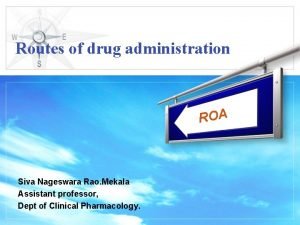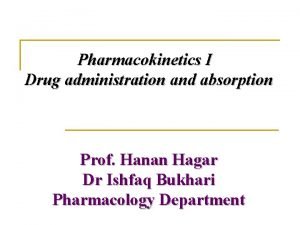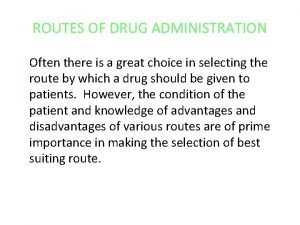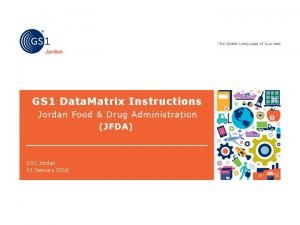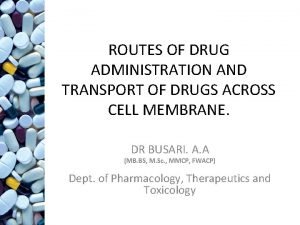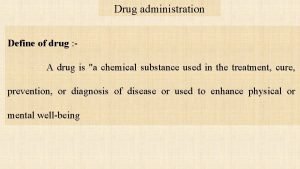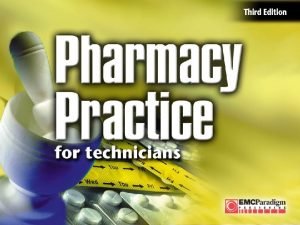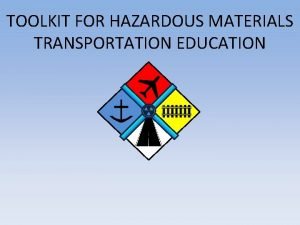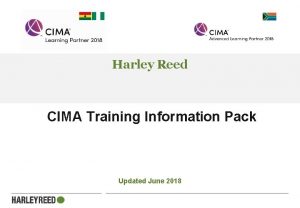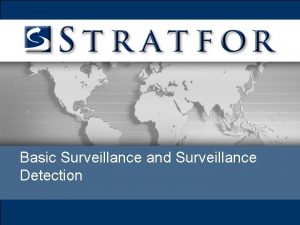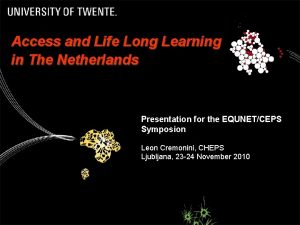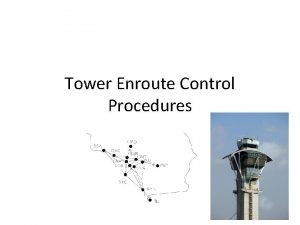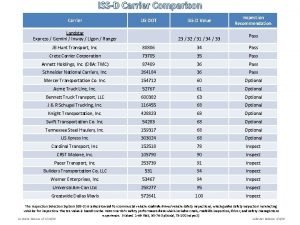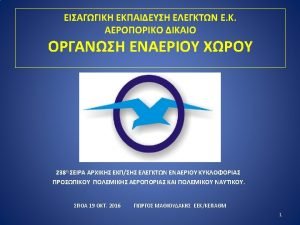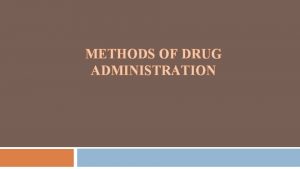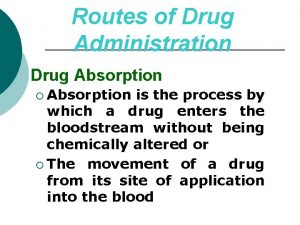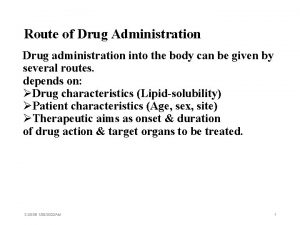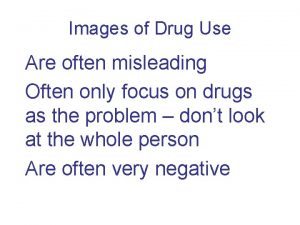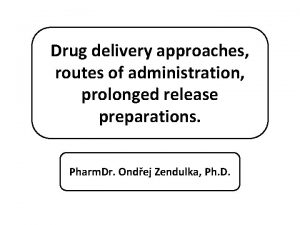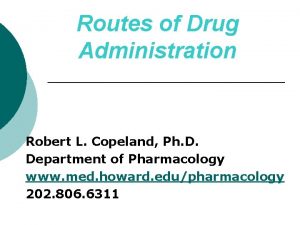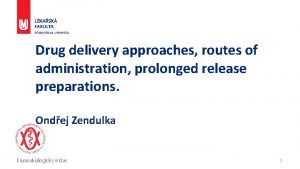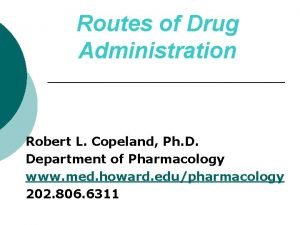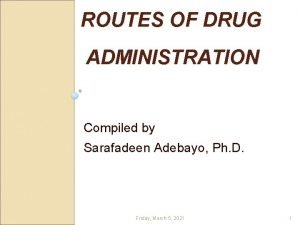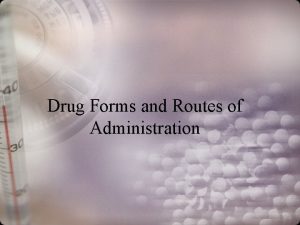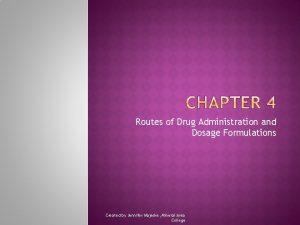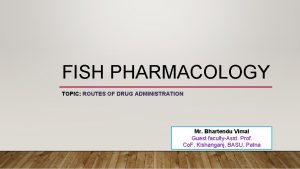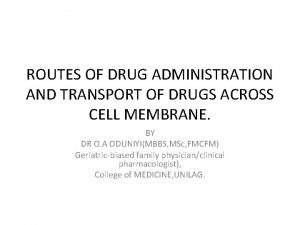ROUTES OF DRUG ADMINISTRATION Often there is a















































- Slides: 47

ROUTES OF DRUG ADMINISTRATION Often there is a great choice in selecting the route by which a drug should be given to patients. However, the condition of the patient and knowledge of advantages and disadvantages of various routes are of prime importance in making the selection of best suiting route.

Following are the different ways by which a therapeutic agent could be given to patients. 1 Enteral 2 Parenteral 3 Inhalation 4 Topical or Local

1. i. ENTERAL OR PER OS (P. O. ) Oral route is the most common route of administration. It is safe, convenient, cheap and does not require the services of a skilled personnel. However, it has certain disadvantages. a) Some drugs are unpalatable and cause irritation of the intestinal tract resulting in nausea, vomiting and diarrhea, in particular if these are given before meal.

b) Some drugs are destroyed by intestinal enzymes e. g. insulin is destroyed by intestinal enzymes. c) In case of emergency, when quick action of a drug is desired this route is not suitable. d) This route is not suitable in the cases of unconscious patients. e) There is a necessity for cooperation on the part of patient.

f) Absorption may be slow, unpredictable and irregular because of the presence of variable amounts of food at various stages of digestion and acidity and alkalinity of the digestive juices might have a great impact on absorption of drugs.

g) A very important factor is that blood from intestinal tract passes via portal vein to the liver where the drug may be metabolized to a great extent before being distributed to the site of action. Thus oral route is not recommended for drug undergoing extensive FIRST PASS EFFECT.

FIRST PASS EFFECT First Pass Effect may be defined as the loss of drug as it passes through the gastrointestinal membranes and the liver, for the first time, during the absorption process after oral administration. This is also known Pre. Systemic elimination. h) Drugs interaction may occur if two drugs are given cocurrently.

ii SUBLINGUAL The tablet is placed under the tongue and absorption form oral mucosa is rapid and uniform. This route has special importance for certain drugs. For example nitroglycerine is effective when given sublingually but ineffective when administered orally. The reason is that the drug has very high lipid solubility.

Also the drug being very potent needs few molecules to be absorbed in order to produce therapeutic effect. The major advantage of this route is that venous drainage from mouth (bucal cavity) is poured into the superior vena cava and the drug is saved from first-pass effect. It nitroglycerine is given by oral route, the hepatic first-pass effect is sufficient to preclude the appearance of any intact nitroglycerine in the systemic circulation.

iii) RECTAL ADMINISTRATION The drug may be given rectally for systemic effect when the patient is either unconscious or vomiting. However, absorption from rectum is irregular and incomplete and may cause irritation of rectal mucosa: Also 50% of the drug absorbed from rectum passes through liver before entering the systemic circulation thus first-pass effect cannot be fully avoided.

The drugs administered reactally are in the form of suppositories e. g. Ergotamine for the treatment of migraine. Another form of preparation for rectal administration is the ENEMA i. e. a solution or suspension of the drug in water or some other vehicle. Suppositories may also be given for local treatment of rectal conditions e. g. benzocain is used to relieve pain and itching caused by haemorrhoids

Advantages of rectal Administration: Drugs could be given by this route in vomiting, motion sickness, migraine or when the patients is unable to swallow the medication. This route is also suitable for drugs that are irritant to the stomach e. g. aminophylline, indomethacin. This route is of particular value in case of children.

Disadvantages of Rectal Administration: a) The patient may be embarrassed. b) Inflammation of rectum may occur due to repeated administration. c) The absorption is irregular specially when rectum is not empty.

2 - PARENTERAL (Par-beyond enteral-intestine) The term parenteral administration implies the routes through which the drug directly reaches the body fluids, by passing the preliminary process of transport through the intestinal wall or pulmonary alveoli which is an essential process when drugs are taken orally, inhaled or administered reactally. Following are the Parenteral routes

a) b) c) d) e) f) g) h) i) j) Subcutaneous (S/C) Intramuscular (I/M) Intravenous (I/V) Intraperitoneal (I/P) Intradermal Intra Medullary Intrathecal Intraarticular Intra-cardiac Intra arterial

The Parenteral administration has certain advantages over oral route. i) Drug is neither invaded nor destroyed by digestive enzymes. ii) A higher concentration of drug in blood may be achieved because the hepatic metabolism of drug due to First-Pass effect is avoided.

iii) Absorption is complete and predictable. iv) In emergency this method is particularly useful. If the patient is unconscious, uncooperative or vomiting, the Parenteral therapy becomes necessary. However, there are certain disadvantages of the parenteral therapy which are as under: i) It is expensive because all the parenteral preparations should be sterilized.

ii) Asepsis must be maintained to avoid infection. iii) An intravascular injection may accidentally occur when it is not actually intended. iv) Pain may accompany or follow the injection. v) It requires the services of a professionally skilled personnel because it is difficult for the patient to perform the injection himself.

a) Subcutaneous: The drug is dissolved in a small volume of vehicle and injected beneath the skin from where the absorption is slow and uniform. Substances causing irritation to the tissues should not be injected otherwise they will cause pain and necrosis (deadening of tissues) at the site of injection.

A diabetic patient making subcutaneous injection in the mouse

This method is particularly useful when continuous presence of the drug in the tissues is needed over a long period. The usefulness of this method is enhanced by the use of depot preparations from which the drug is released more slowly than it is from simple solution e. g. long-acting insulins. Another form of the depot preparation is subcutaneous implant.

In this case, a sterile pellet is implanted into subcutaneous tissue instead of injecting drug solution e. g. hormones are administered in this way. If a vasoconstrictor agent is incorporated in a drug solution, it retards the absorption e. g. adrenaline is combined with local anesthetics to prolong the local anesthesia. b) Intramuscular: Injection is made deep into the muscle tissue.

In humans, the best site is deltoid muscle in the shoulder or the gluteus muscle in the buttocks. This method is suitable for the irritating substances that cannot be given by subcutaneous route. The speed of absorption from site of injection is dependent on the vehicle used, absorption is quick from aqueous solutions and slow from oily preparations. Absorption is complete, predictable and faster than subcutaneous route.

Intramuscular injection in deltoid and gluteal muscles

Intravenous: Drug solution in injected directly into the lumen of a vein so that it is diluted in the venous blood. The drug is carried to the Heart and circulated to the tissues. Drugs in oily vehicle or those that cause haemolysis should not be given by this route. Since the drug is introduced directly into blood, the desired concentration of the drug is achieved immediately which is not possible by any other procedure.

Intravenous Administration

This route is of prime importance in emergency. Also certain irritant drugs could be given by this route. Also this is the only route for giving large volume of drugs e. g. blood transfusion. However, there are certain disadvantages of this procedure. 1. Once the drug is injected nothing can be done to prevent its action. 2. I/v injection requires technical skill to minimize the risk of leakage of irritant solution into the surrounding tissues. 3. Air embolism may cause serious problems.

Intraperitoneal: The peritoneum offers a large absorbing surface area from which drugs enter circulation rapidly but primarily by way of portal vein. Hence First-Pass effect not avoided. This is probably the most widely used route of drug administration in laboratory animals. In human, it is very rarely employed due to the dangers of infection and injury to viscera and blood vessels.

Inraperitoneal Injection

e) Intradermal: Drug are injected into papillary layer of skin. For example tuberculin injection for montoux test and BCG vaccination for active immunization against tuberculosis. BCG: Bacille Calmette-Guerin

Administering Intradermal Injections: 1. Check physician's order 2. Prepare equipment: Draw up 0. 1 ml of the medication in a 1 cc syringe - ones called a TB/tuberculin syringe. Collect medication, procedure gloves, alcohol wipe, and cotton ball 3. Cleanse the site with an alcohol pad going in a circular motion 4. Hold the skin taut

5. Hold the needle at a 15 degree angle to the skin with the bevel facing up. 6. Insert the needle through the skin, just below the epidermis into the dermis. 7. Inject the fluid, making a bubble just below the skin 8. Remove the needle 9. Dispose of used syringe and needle in a Sharps container


Intradermal Injection


f) Intra Medullary: The needle is introduced into marrow cavity and effects are similar to those following intravenous injection. This route is used when veins are not available specially in children. In adults the injection is made into marrow cavity of sternum and under 3 years of age into that of tibia or femur. g) Intrathecal: Blood brain barrier often prevents the entry of certain drugs into the central nervous system.

Also the blood CSF barrier prevents the approach of drugs to the meninges. Thus when local and rapid effects of drugs on meninges are desired the drugs are injected into Subarachnoid (between arachnoid mater and pia mater)space and effects of the drugs are then localized to the spinal nerves and meninges e. g. intrathecal injection of streptomycin in tuberculosis and meningitis used to be used by this route but with the invention of third generation cephalosporins it is not used any more to treat these conditions. The injection of local anaesthetics for the induction of spinal anaesthesia is given by this route.

(the three membranes covering the brain and spinal cord from outside to inward are dura mater, arachnoid mater and pia mater) h) Intra articular: It is also known as intra synovial. Sometimes drugs are injected into the joint cavity to localize their action at the site of administration e. g. Hydrocortisone acetate in the treatment of rheumatoid arthritis. Local anesthetic is added to minimize pain of injection. Strict aspesis must be maintained to avoid joint-infection.

i) j) Intra Cardiac: In cardiac arrest intracardiac injection of adrenaline is made for resuscitation. Intra-arterial: Sometimes a drug is injected directly into an artery to localize its effects in a particular tissue or organ. However, therapeutic value of such practice is doubtful.

Infact in human the use of this technique is restricted to the injection of radio-opaque media for diagnostic purposes. A competent person is required to inject the drug intra arterially. However, there is no fear of firstpass effect when the drug is given by this route.

3 - INHALATION Inhalation or Pulmonary Absorption: Gaseous and volatile drugs may be inhaled. They are then absorbed by pulmonary endothelium and mucous membrane of the respiratory tract and reach circulation rapidly. Volatile or gaseous anaesthetics such as halothane, enflurane and nitrous oxide are administered by this route.

Bronchodilators are generally given from inhalers in aerosol form. Now inhalers have been developed which allow the supply of accurately metered doses of drugs. This development has greatly extended the scope of this technique.

4 LOCAL OR TOPIOCAL APPLICATION a) Skin Drugs applied locally on the skin are poorly absorbed through the epidermis. However, dermis is permeable to many solutes. Thus systemic absorption of drugs occurs more readily through abraded, burned or denuded skin. Inflammation and other conditions that enhance cutaneous blood flow also promote absorption.

Drugs are applied in the form of ointments, pastes, poultice and cream to the skin for their local action. However, absorption through skin can be increased by suspending the drug in an oily vehicle and rubbing the preparation into the skin. This method of administration is called inunction. b) Mucous Membranes: Drugs are applied onto the various mucous membranes for their local action.

i) Mouth and Pharynx: Bitters are used for their reflex action to improve digestion. Boroglycerine and gentian violet paint (as astringent) are used for their effects on buccal mucosa. ii) Stomach & Intestine: Antacids (to neutralize secreted HCl) and emetics ( to induce emesis) are used for their local effect iii) Rectum: - Drugs are applied in the form of suppository or enemas e. g. glycerin suppository for their local action. Drugs are employed for relief of itching and pain in haemorrhoid.

iv) Respiratory Tract: In infections of respiratory tract, tincture benzoin co steam inhalations give relief from nasal congestion, phenyl ephrine nasal drops are also used for nasal congestion. v) Vagina: The drugs are used in the form of pessary or tablet to treat the vaginal infections. Although this method can be applied for the drugs that are absorbed through vaginal mucous membrane into the circulation, it is restricted to the local treatment of vaginal conditions

vi) Conjunctivae: Mydriatics ( to dilate pupil), miotics (to constrict the pupil), local anaesthetics antiseptics and antibiotics are applied to the conjunctivae for their local action. Conjunctiva: The delicate membrane lining the eyelids and covering the eye ball.
 Roa medication
Roa medication Factors affecting absorption of drug
Factors affecting absorption of drug Parenteral route definition
Parenteral route definition Summary of drug administration
Summary of drug administration Intradermal drug administration
Intradermal drug administration Nonparenteral
Nonparenteral Jordan food and drug administration
Jordan food and drug administration Route of administration of drugs definition
Route of administration of drugs definition Drug administration definition
Drug administration definition Parenteral route
Parenteral route Intrathecal route advantages and disadvantages
Intrathecal route advantages and disadvantages An example of crude drug adulterated with exhausted drug
An example of crude drug adulterated with exhausted drug Usually always never often sometimes
Usually always never often sometimes Minoan trade routes
Minoan trade routes What requirements must exit routes meet?
What requirements must exit routes meet? Routes for learning map
Routes for learning map Les plus belles routes de montagne en france
Les plus belles routes de montagne en france Prillaman hall ksu
Prillaman hall ksu Why did constantinople become a rich and powerful city
Why did constantinople become a rich and powerful city Preferred ifr routes
Preferred ifr routes Transport routes in sap
Transport routes in sap Hazmat restricted routes
Hazmat restricted routes Camel saddle ap world history
Camel saddle ap world history Mechanically altered diet examples
Mechanically altered diet examples Tamu bus route 35
Tamu bus route 35 Where did vikings originate from
Where did vikings originate from Bureaucracy
Bureaucracy Trade routes 1500
Trade routes 1500 Routes to work
Routes to work Cima gateway route
Cima gateway route Sdr surveillance detection route
Sdr surveillance detection route Kennis learning routes llp
Kennis learning routes llp Cognitively based attitude
Cognitively based attitude Tower enroute control
Tower enroute control Byzantine trade routes
Byzantine trade routes Persian empire trade routes
Persian empire trade routes Colonial slavery apush
Colonial slavery apush Trans saharan trade route
Trans saharan trade route Double move routes
Double move routes Express group routes
Express group routes Trade routes in the 1500s
Trade routes in the 1500s Landstar express routes
Landstar express routes Aixm training
Aixm training Ducks migrating
Ducks migrating Dutch exploration routes
Dutch exploration routes Central route of persuasion
Central route of persuasion Fir athens
Fir athens Gupta empire trade routes
Gupta empire trade routes
